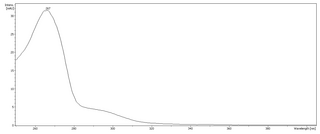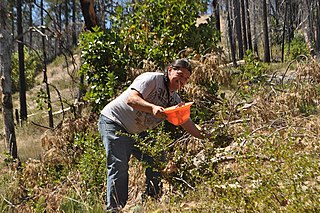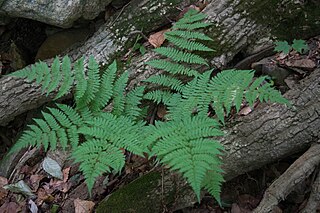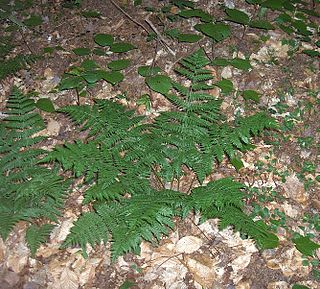
Dryopteris, commonly called the wood ferns, male ferns, or buckler ferns, is a fern genus in the family Dryopteridaceae, subfamily Dryopteridoideae, according to the Pteridophyte Phylogeny Group classification of 2016 (PPG I). There are about 300-400 species in the genus. The species are distributed in Asia, the Americas, Europe, Africa, and the Pacific islands, with the highest diversity in eastern Asia. It is placed in the family Dryopteridaceae, subfamily Dryopteridoideae, according to the Pteridophyte Phylogeny Group classification of 2016 (PPG I). Many of the species have stout, slowly creeping rootstocks that form a crown, with a vase-like ring of fronds. The sori are round, with a peltate indusium. The stipes have prominent scales.

Rubus parviflorus, commonly called thimbleberry, is a species of Rubus native to northern temperate regions of North America. The plant has large hairy leaves and no thorns. It bears edible red fruit similar in appearance to a raspberry, but shorter, almost hemispherical. It has not been commercially developed for the retail berry market, but is cultivated for landscapes.

Dryopteris expansa, the alpine buckler fern, northern buckler-fern or spreading wood fern, is a species of fern native to cool temperate and subarctic regions of the Northern Hemisphere, south at high altitudes in mountains to Spain and Greece in southern Europe, to Japan in eastern Asia, and to central California in North America. The species was first described from Germany. It prefers cool, moist mixed or evergreen forests and rock crevices on alpine slopes, often growing on rotting logs and tree stumps and rocky slopes. It is characteristically riparian in nature, and is especially associated with stream banks.

Phloroglucinol is an organic compound with the formula C6H3(OH)3. It is a colorless solid. It is used in the synthesis of pharmaceuticals and explosives. Phloroglucinol is one of three isomeric benzenetriols. The other two isomers are hydroxyquinol (1,2,4-benzenetriol) and pyrogallol (1,2,3-benzenetriol). Phloroglucinol, and its benzenetriol isomers, are still defined as "phenols" according to the IUPAC official nomenclature rules of chemical compounds. Many such monophenolics are often termed "polyphenols" by the cosmetic and parapharmaceutical industries, which does not match the scientifically accepted definition.

The Karuk people are an indigenous people of California, and the Karuk Tribe is one of the largest tribes in California. Karuks are also enrolled in two other federally recognized tribes, the Cher-Ae Heights Indian Community of the Trinidad Rancheria and the Quartz Valley Indian Community.

The Sierra Ancha is a mountain range in Gila County, in central Arizona. It lies between Roosevelt Lake to the south, the Tonto Basin to the west, Cherry Creek to the east, and Pleasant Valley to the north. The range is one of several, including the Bradshaw Mountains, Mingus Mountain of the Black Hills, and the Mazatzal Mountains, which form a transitional zone between the lowland deserts of southern Arizona and the Colorado Plateau of northeastern Arizona. The highest point in the range is Aztec Peak, at an elevation of 2345 m (7694 ft).

Vaccinium ovatum is a North American species of flowering shrub known by the common names evergreen huckleberry,winter huckleberry,cynamoka berry and California huckleberry.

Dryopteris arguta, with the common name coastal woodfern, is a species of wood fern. It is native to the west coast and western interior mountain ranges of North America, from British Columbia, throughout California, and into Arizona.

Daucus pusillus is a species of wild carrot known by the common names American wild carrot and rattle-snake-weed. Its Latin name means "little carrot", or "tiny carrot". It is similar in appearance to other species and subspecies of wild carrot, with umbels of white or pinkish flowers.

Adiantum jordanii is a perennial species of maidenhair fern, in the Vittarioideae subfamily of the Pteridaceae. The species is known by the common name California maidenhair.

Dryopteris carthusiana is a species of fern native to damp forests throughout the Holarctic Kingdom. It is known as the narrow buckler-fern in the United Kingdom, and as the spinulose woodfern in North America.

Camissoniopsis lewisii is a species of evening primrose known by the common name Lewis' evening primrose. It is native to southern California and Baja California, where it grows in coastal habitat and on the grasslands of the inland mountain ranges. as an example occurrence in Baja California, C. lewisii occurs in association with Mimulus aridus and Adiantum jordanii.

Prosartes hookeri is a North American species of flowering plants in the lily family known by the common names drops of gold and Hooker's fairy bells.
The Salome Wilderness of Tonto National Forest is a protected area in the rim country of the southwestern US. The Salome Wilderness lies within the Sierra Ancha mountain range in Gila County, Arizona.
Salome Creek is a watercourse in the Salome Wilderness in central Arizona, United States.

Workman Creek is a watercourse in the Salome Wilderness in central Arizona, United States.
Diplacus aridus, is a species of monkeyflower with yellow blossoms. It was formerly known as Mimulus aridus.

Dryopteris intermedia, the intermediate wood fern or evergreen wood fern, is a perennial, evergreen wood fern native to eastern North America. It is a diploid species, and is the parent of several species of hybrid origin, including Dryopteris carthusiana. Other common names for this species include intermediate shield fern, fancy wood fern, fancy fern, glandular wood fern, American shield fern and common wood fern.















